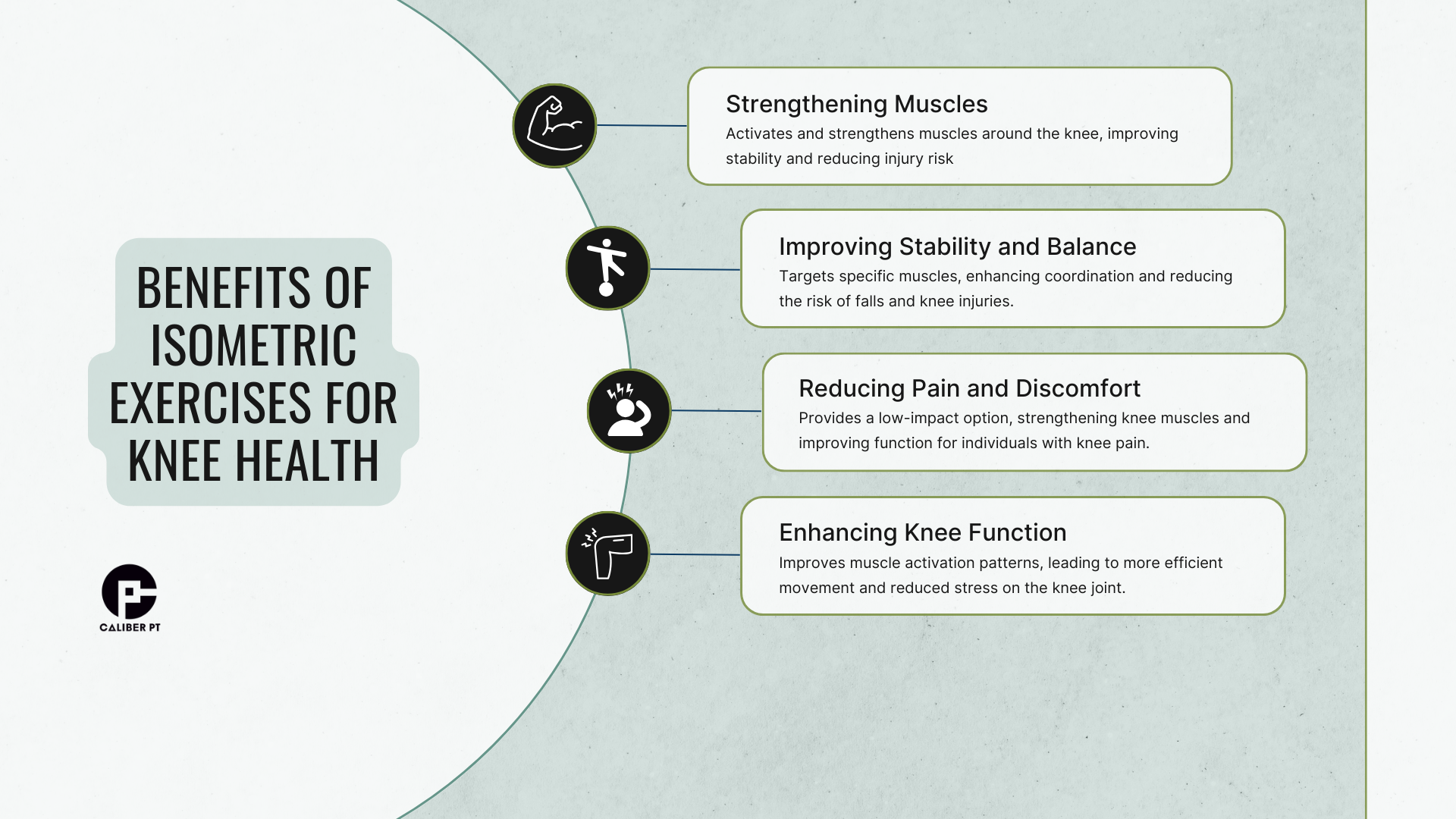© Copyright 2023 Caliber PT PLLC - All Rights Reserved
Isometric exercises have gained significant attention in recent years due to their effectiveness in improving muscle strength and stability. Specifically, isometric exercises for knee health have emerged as a valuable tool for athletes, sports enthusiasts, and individuals experiencing knee pain or injury. The knees play a crucial role in various sports activities and daily movements, making it essential to prioritize their health and well-being.
Knees are vital joints that support our body weight and facilitate movement, thus, keeping them strong and healthy is crucial, particularly for athletes and active individuals. Isometric exercises help strengthen knee-surrounding muscles without stressing the joint.
Isometric exercises, unlike traditional dynamic exercises, involve static muscle contractions, making them safe for individuals with knee issues as they do not worsen their conditions.
Incorporating isometric exercises into one’s fitness routine can enhance muscular endurance, stability, and overall knee function. They target the quadriceps muscles, alleviating pressure on the knees during physical activities, and reducing injury risks such as ligament tears or meniscus damage.
Moreover, isometric exercises promote neuromuscular control and proprioception – your body's awareness of its position in space – which are essential factors in preventing sports-related knee injuries. By enhancing these aspects, you can improve balance and coordination while reducing the likelihood of falls or missteps that may lead to knee trauma.
Additionally, performing isometric exercises regularly can help alleviate existing knee pain by increasing blood flow to the area and promoting healing. These exercises can be particularly beneficial for individuals with conditions such as patellofemoral pain syndrome or arthritis, as they provide a low-impact option for strengthening the knee muscles and reducing discomfort.
Preventing Knee Pain and Injury with Isometric Exercises
Preventing Knee Pain and Injury with Isometric Exercises
Understanding the causes of sports-related knee pain and injury Sports-related knee pain and injuries are common among athletes and individuals who engage in physical activities. These injuries can occur due to various factors, including overuse, improper technique, muscle imbalances, and weak or unstable knees. It is crucial to understand the causes of knee pain and injury in order to effectively prevent them. Isometric exercises can play a significant role in addressing these causes and reducing the risk of knee pain and injury.
Exploring the role of isometric exercises in injury prevention Isometric exercises involve contracting specific muscles without any movement at the joint. Unlike dynamic exercises that involve joint movement, isometric exercises target specific muscles and help improve their strength and stability. This can be particularly beneficial for preventing knee pain and injuries as it allows for targeted strengthening of the muscles surrounding the knee joint.
One of the key roles that isometric exercises play in injury prevention is improving muscle balance around the knee joint. Muscle imbalances, such as weak quadriceps or hamstrings compared to other muscle groups, can put excessive stress on the knee joint during physical activities. By incorporating isometric exercises into a training routine, athletes can develop balanced strength in their leg muscles, reducing the risk of overloading the knee joint.
Specific isometric exercises for different sports and activities The choice of isometric exercises may vary depending on an individual's specific sport or activity. Different sports require different movements and place varying demands on the knees. Therefore, it is important to select isometric exercises that target the relevant muscle groups involved in those movements.
For example, athletes involved in running sports may benefit from performing wall sits or static lunges to strengthen their quadriceps muscles. These exercises involve holding a static position with bent knees for a certain period of time, thereby engaging and strengthening the quadriceps without placing excessive stress on the knees.
On the other hand, individuals participating in sports that involve jumping and landing, such as basketball or volleyball, may find exercises like the single-leg wall squat or the static squat useful. These exercises focus on strengthening the gluteal muscles and quadriceps while also improving stability and control during landing.
In addition to sport-specific exercises, there are general isometric exercises that can benefit anyone looking to prevent knee pain and injury. These include isometric leg extensions, where you sit on a chair with your knees bent at a 90-degree angle and push against an immovable object with your lower legs. This exercise targets the quadriceps muscles and helps improve their strength and stability.
Tips for incorporating isometric exercises into a training routine To effectively prevent knee pain and injury with isometric exercises, it is important to incorporate them into a well-rounded training routine. Here are some tips for integrating these exercises:
Start gradually: If you are new to isometric exercises or have existing knee issues, start with easier variations of the exercises and gradually increase intensity as your strength improves.
Proper form: Pay attention to proper form and technique while performing isometric exercises. This ensures that you are targeting the intended muscle groups without placing unnecessary stress on the knees.
Consistency: Consistency is key when it comes to reaping the benefits of isometric exercises for knee health. Aim to perform these exercises at least two to three times per week for optimal results.
Balance with other forms of exercise: While isometric exercises can be highly beneficial for knee health, it's important to maintain a balanced fitness routine that includes other forms of exercise such as cardiovascular training, flexibility work, and dynamic strength training.
By incorporating these tips into your training routine, you can maximize the benefits of isometric exercises for preventing knee pain and injury.
Proper Technique and Form for Isometric Knee Exercises
Isometric exercises are a valuable tool for improving knee health and preventing sports-related knee pain and injuries. However, it is essential to perform these exercises with proper technique and form to maximize their effectiveness and minimize the risk of further injury. In this section, we will provide a step-by-step guide on how to perform isometric knee exercises correctly, highlight common mistakes to avoid, discuss progression and modification options, as well as outline safety precautions and considerations.
Step-by-Step Guide:
Warm-up: Before starting any exercise routine, it is crucial to warm up your muscles and joints. Perform light cardio exercises such as jogging or cycling for 5-10 minutes to increase blood flow and loosen up the muscles surrounding your knees.
Choose the Right Exercise: There are several isometric exercises specifically targeting the knee joint. Some popular options include wall sits, quad sets, hamstring sets, and calf raises. Select an exercise that best suits your needs and consult with a healthcare professional if you have any underlying conditions or concerns.
Proper Body Positioning: To ensure proper technique during isometric knee exercises, pay attention to your body positioning. Stand tall with your feet shoulder-width apart and maintain good posture throughout the exercise. Keep your core engaged and avoid leaning forward or backward.
Engage the Target Muscles: Once in the correct position, focus on engaging the target muscles around your knees. For example, during a wall sit exercise, squeeze your quadriceps (thigh muscles) while maintaining a 90-degree angle at your knees. Hold this contraction for a specific duration (e.g., 10-30 seconds) before releasing.
Common Mistakes to Avoid:
Holding Your Breath: Many individuals tend to hold their breath while performing isometric exercises due to exertion or concentration. Remember to breathe naturally throughout each repetition as holding your breath can increase tension in your muscles and may lead to dizziness or lightheadedness.
Overexertion: It is important to listen to your body and avoid pushing yourself too hard, especially if you are a beginner or have existing knee issues. Start with shorter holds and gradually increase the duration as your strength improves. Pushing beyond your limits can strain the muscles and potentially worsen knee pain or cause injury.
Progression and Modification Options:
Increasing Hold Time: As your strength and endurance improve, gradually increase the duration of each isometric contraction. Aim for 30-60 seconds per repetition to challenge your muscles further.
Adding Resistance: Once you have mastered the basic isometric exercises, consider incorporating resistance bands or weights to add an extra challenge. This can help build strength in the muscles surrounding your knees and enhance overall stability.
Safety Precautions and Considerations:
Consult with a Professional: If you have any pre-existing knee conditions or concerns, it is advisable to consult with a healthcare professional before starting an isometric exercise routine. They can provide personalized guidance based on your specific needs and limitations.
Pain vs Discomfort: While performing isometric exercises, it is normal to feel some discomfort or muscle fatigue. However, if you experience sharp pain or worsening of existing knee pain during the exercises, stop immediately and seek medical advice.
Mastering the proper technique and form for isometric knee exercises can greatly benefit your overall health and well-being. These exercises are not only effective in improving knee strength, but they also help reduce the risk of injury during physical activities.
By following a step-by-step guide tailored to your fitness level, you can easily incorporate these exercises into your routine. Avoiding common mistakes along the way will further enhance their effectiveness. Remember that safety should always be prioritized, so it's important to consider precautionary measures as you engage in these exercises.
Consistency plays a pivotal role in achieving long-term results – make sure to stay committed! Listen attentively to what your body needs throughout this journey towards better knee health. You'll soon notice improvements and experience less pain or discomfort when participating in sports or other active pursuits.
It's never too late (or early) to take care of yourself! Embrace regular practice with enthusiasm while keeping an eye on safety precautions; trust us, your knees will thank you for it.


